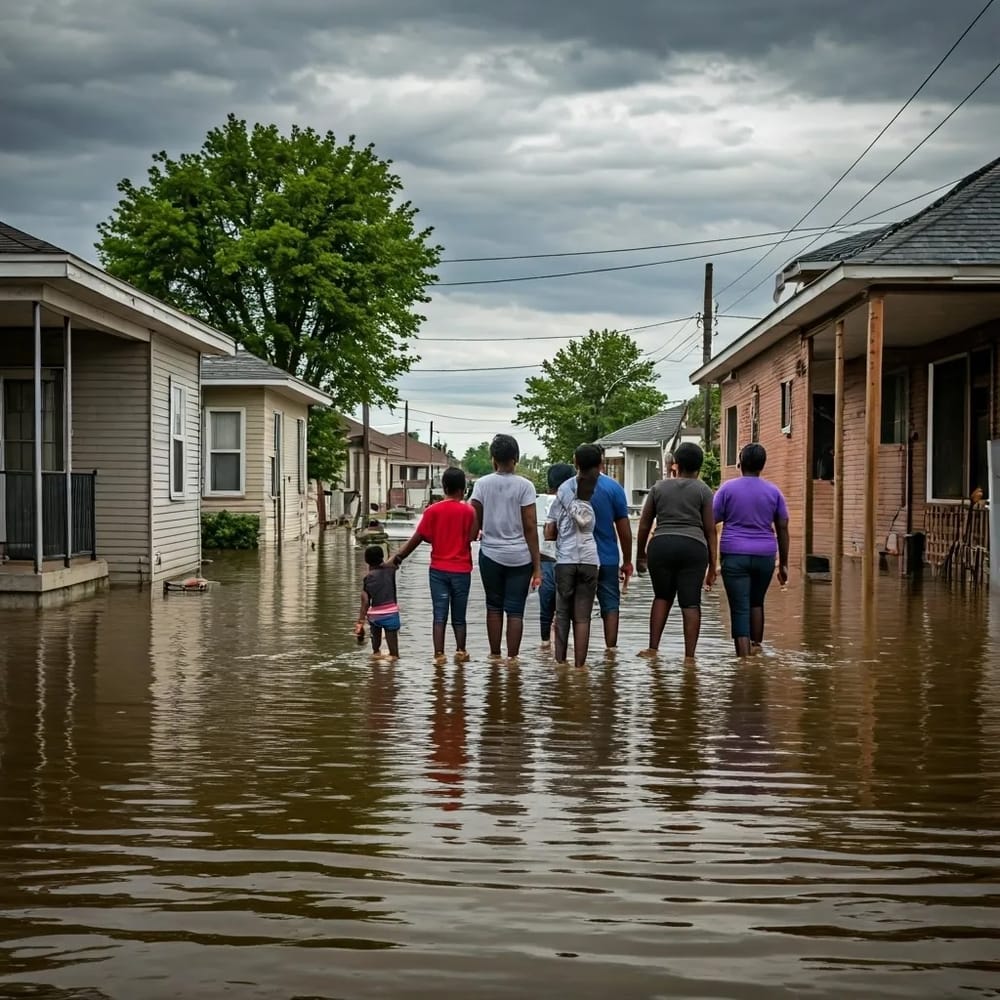The recent flooding in central Texas is nothing short of tragic. There are no words for the parents who lost children at a camp.
The part that stings is public officials knew in advance that these rural communities had outdated infrastructure and flood warning systems .
So if there is any way to take lessons from the floods, it’s this, before tragedy strikes again.
Heavy rain and floodwaters may fall equally across a city or region, but the devastation rarely does. For Black communities in the United States, this truth has been painfully clear after most flood-related disaster in recent years — from the submerged neighborhoods of New Orleans after Hurricane Katrina to the recent catastrophic flood in cities like Houston, Detroit, and Atlanta.
While the recent Texas floods hit rural central Texas, had the rains hit major metropolitan areas, it would have been Black communities which would’ve fared the worst.
Floods are natural events. But who gets washed out and who gets rebuilt — those are political outcomes shaped by centuries of discriminatory policies. Historically, Black Americans have been pushed into low-lying, flood-prone areas through redlining, restrictive covenants, and economic marginalization. These neighborhoods often lack robust drainage, updated levee systems, or any real investment in resilient infrastructure.
Take redlining, the 20th-century practice where the federal government and banks denied mortgages and insurance to Black families living in “hazardous” zones. Many of those zones were designated not because of actual environmental risks, but because Black people lived there. Denied the opportunity to build wealth in safer, higher-elevation neighborhoods, Black families were corralled into poorly drained areas near industrial zones, floodplains, and coastal wetlands.
Those maps may be out of circulation, but their consequences flood forward even to today.
It’s not just where people live — but what gets built or fixed. Flood-prone neighborhoods in Black communities often lack green infrastructure like retention ponds, permeable pavements, and updated stormwater systems. Meanwhile, wealthier, whiter neighborhoods are protected by stronger levees and receive faster emergency responses and more generous insurance payouts.
Consider Hurricane Harvey in 2017. In Houston, some of the worst flooding occurred in historically Black neighborhoods, many of which had been located near bayous and drainage channels. Research by the Natural Resources Defense Council found that Black residents were twice as likely as white residents to live in areas with high flood risk and little protection.
Even when the water recedes, the damage lingers — mold infestations, displacement, and long delays in rebuilding are far more common in Black communities, where residents are less likely to have flood insurance or the resources to start over.
After disasters, it only gets worse from there because aid is rarely distributed equitably. Studies show that FEMA assistance and federal rebuilding funds often favor whiter and wealthier applicants. In fact, a 2019 study published in Social Science Research found that white Americans were more likely to gain wealth after natural disasters due to insurance payouts and rebuilding subsidies, while Black families lost wealth.
Why? Because the systems in place — insurance underwriting, grant applications, zoning approvals — are often biased in ways that reward existing status and penalize need.
And when Black neighborhoods do receive rebuilding funds, they’re often used to build back the same flawed infrastructure that failed in the first place, or worse, used to gentrify and displace the original residents entirely.
Now that climate change is making floods more frequent and more severe, what’s coming to Black communities is only going to go from bad to much much worse if nothing is done. According to the EPA, heavy rainfall events in the U.S. have increased significantly over the past century — especially in the Northeast and Southeast. For Black communities already sitting on the front lines of flooding, the risk is compounding.
A recent study in Nature Climate Change found that Black Americans are 40% more likely than white Americans to live in areas with high flood risk. And those risks are often layered on top of other vulnerabilities — poor air quality, industrial pollution, food deserts — that also stem from historical racist planning policies.
It’s not enough to build back better — we need to build back fairer.
- Flood mitigation efforts must prioritize the most vulnerable neighborhoods — not the wealthiest.
- Disaster aid must be distributed equitably, with accountability and transparency.
- Infrastructure investments must include green solutions in Black communities — not just concrete fixes.
- Housing justice must be part of climate plans. That means ending displacement and giving communities power over how they rebuild.
The Central Texas floods must be our wake up call to demand reparative justice — not just reacting to disaster. We must reckon with the past that has made some people more disaster prone than others.
Water doesn’t lie. It finds every crack in the system. And those cracks had and have names: redlining, environmental racism, neglect, and greed.
Until we address the impact of these, the flood will come for Black communities first when they hit the next major city — and leave them behind last.
This post originally appeared on Medium and is edited and republished with author's permission. Read more of Jeffrey Kass' work on Medium.
